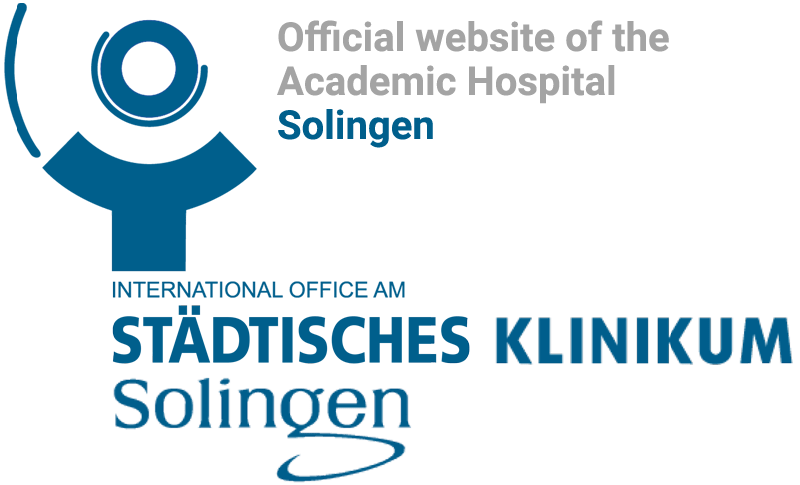Спектр услуг
Удобства
The Clinic of Nephrology has 66 beds and 19 dialysis places with outpatient department for renal diseases, high blood pressure and transplantation follow-up, and ultrasound examination
– a laboratory with color duplex sonography.
Medical profile of the Clinic covers the general spectrum of diseases of kidneys and high blood pressure, especially acute and chronic kidney failure, including diagnostics and therapy of systematic vasculitis and bone metabolism
diseases.
In cooperation with our Clinic for Vascular Surgery, the installation of all accesses to vessels, including the installation of shunting for dialysis and vascular prosthesis is used. The special field of internal medicine has general
educational authority for the specialty of internal medicine; in addition, there is full authority for the development of skills for the Department of nephrology.
Key areas:
- Kidney diseases: Diagnostics, including bipsy of “native” and transplanted kidneys, as well as treatment of kidney diseases: glomerulonephritis, lupus erythematosus, erythematous and other collagenoses, vasculitis, hereditary kidney diseases.
- High blood pressure: detection of secondary forms of hypertension in severely regulated arterial hypertension, including duplex sonography of the renal arteries
- Diagnostics and immunosuppressive therapy of all diseases of the rheumatic range, including hereditary diseases.
- Realization of all processes of blood purification in case of renal failure and poisoning.
- Hemodialysis, hemodial filtration,
- Continuous process of kidney replacement (CVVH, CVVHD, CVVHDF),
- Regional anticoagulation with citrate in intermittent and continuous dialysis,
- Plasmapheresis, immune adsorption
- Lipid apheresis on request,
- Peritoneal dialysis (CAPD, APD, IPD)
- Establishment of indications and implementation of renal replacement process in intensive area
- Diagnostics and treatment of metabolic disorders of the bone marrow
- Transplantation: treatment of patients before and after kidney transplantation, including long-term monitoring
- Angiologic diagnostics: ultrasound diagnostics with color coded duplex sonography and Doppler examination of the renal arteries, extremities, supraaortal and intracranial vessels
- Preparation and organization of home hemodialysis and peritoneal dialysis
Possibilities of dialysis: Clinical dialysis
- 7 medical places
- Hemodial filtration, hemodialysis, hemofiltration and plasmapheresis
- Patients with hepatitis B, hepatitis C and HIV
- Patients with Staphylococcus aureus, methicillin-resistant (MRSA) and extended-spectrum beta-lactamase (ESBL)
- Emergency care is provided around the clock’ there is a 24-hour call preparedness for dialysis staff and chief doctors.
Possibilities of dialysis: Outpatient dialysis
- 12 medical places
- Hemodial filtration, hemodialysis, hemofiltration
Our patients are served in two shifts per day, on the following days: Monday, Wednesday and Friday and one shift Tuesday, Thursday and Saturday. We also offer nighttime dialysis on the following days: Monday, Wednesday and Friday.
Renal replacement therapy
Symptoms of uremia:
In the human body, metabolic products are produced daily, which, together with blood, are
transported to the kidneys and then removed from the body. Along with the purification of blood, another task of the kidneys is to remove water. Kidney diseases lead to the limitation of their functional ability. Therefore, their
excretory function and detoxification function are reduced. Because of this, metabolic products and water accumulate in the body, which leads to the progression of the disease. In the case of development of kidney disease before
this stage and in the absence of a donor kidney, metabolic products and water are excreted by the blood purification procedure. This procedure is called dialysis.
Possibilities of purification of blood:
One of the possibilities of dialysis is the purification of blood with the help of an apparatus that purifies blood outside the body through an artificial dialysis membrane (hemodialysis). Another method of purifying the blood is
peritoneal dialysis. Here, as a natural dialysis membrane, the peritoneum is used.
Hemodialysis
Over the past 40 years, hemodialysis (blood purification) has become a standard procedure for renal replacement therapy. In Germany, about 50,000 patients are currently undergoing hemodialysis.
For what reason and in what cases is the hemodialysis procedure necessary?
The kidney is the most important organ of excretion. It continuously produces urine and, together with it, removes toxins and excess liquid from the body. With a decrease in kidney function, the concentration of waste in the blood
increases. At the same time, fluid is not completely removed from the body, which leads to hyperhydration and worsening of the situation with high blood pressure.
If the functional capacity of the kidneys falls below 15% of the norm, due to insufficient removal of toxins and fluids, symptoms such as fatigue, lack of appetite, decreased efficiency, shortness of breath, poorly amenable correction
of high blood pressure, impaired sensitivity, inflammation of the mucosa stomach, heart rhythm disturbances or even inflammation of the pericardial sac. With the help of effective treatment through hemodialysis, the excretory function
of the kidneys can be compensated so much that these complaints no longer arise, while the patient’s capacity for work is largely preserved.
What happens during hemodialysis?
In hemodialysis, slags, medications and other substances that are normally excreted by healthy kidneys along with the urine are removed from the blood, and excess fluid is filtered. The patient’s blood is pumped by the dialysis pump
through the thin capillary tubes of the dialyzer, outside these tubes are washed with a constantly renewable washing liquid. In this case, slags through the walls of the tubes penetrate from the blood into the washing liquid, and
thus are removed from the blood. At the same time, due to the pressure difference between the blood flow and the rinsing solution regulated by the dialysis apparatus, the liquid from the blood through the dialysis membrane is filtered
out into the washing liquid.
Peritoneal dialysis
Peritoneum is thin and shiny skin, its surface is from 1 to 2 m2 and completely covers the abdominal cavity. Since the peritoneum is well supplied with blood, it is an excellent replacement membrane. To conduct peritoneal dialysis
in the abdominal cavity at the regular intervals through a firmly inserted catheter into the skin of the abdomen, a special liquid (washing solution, dialyzer) is supplied. This liquid washes the peritoneum. Since renal insufficiency
accumulates metabolic products in the blood, these substances are discharged through small blood vessels into the washing liquid. After several hours, the substance saturated with substances is removed through the catheter and replaced
with a new liquid for dialysis. Thanks to this, a new purification process begins, proceeding in a gentle and natural way. Along with the metabolic products from the human body, suffering from kidney disease, an excess fluid must
be eliminated, among other things. To this end, glucose is added to the dialysis fluid. Glucose has the ability to draw fluid from small blood vessels of the peritoneum and, thus, to release the human body from excess fluid. Unlike
the procedure for detoxification during hemodialysis, which is usually performed 3 times a week for 4-5 hours, peritoneal dialysis is performed in the slow and constant mode (continuously). Thus, this procedure is very similar to
the natural process of detoxification occurring in the kidneys.
Kidneys and diabetes
Due to the constantly elevated blood sugar levels, small blood vessels are destroyed in the body over time. In the kidneys, the filter apparatus, consisting of small blood
vessels, is primarily affected. The first sign of diabetic nephropathy is the excretion of certain protein (albumin) with urine. The loss of albumin develops long before the onset of serious lesions. Patients suffering from diabetes
should pass urinalysis to identify albuminuria at least once a year.
After the stabilization of blood pressure and the appointment of the proper treatment for diabetes, the loss of albumin may stop. If the kidney damage continues, the structure of the renal filtration apparatus is disturbed so much
that there are holes and blockages in the renal corpuscles. In this case, there is insufficient purification of the blood. Vital substances (including other proteins along with albumin) are excreted in the urine. Decomposition products
(e.g. urea) are not completely eliminated from the body. They fall back into the bloodstream. This can lead to urine intoxication (uremia). Ultimately, the kidney cells lose their function. However, it is in the case of diabetes
mellitus that it is possible to slow the loss of kidney function through strict monitoring of blood pressure. Careful treatment of even a slight increase in blood pressure is very important. However, the lack of treatment for limited
renal function can lead to chronic impairment of renal function (renal failure). In this case, a permanent replacement renal therapy (dialysis or transplantation) is necessary throughout life.
In Germany, about four million diabetics live; in addition, according to rough estimates, another two million people have diabetes mellitus, which has not yet been diagnosed. In addition, experts expect that the number of diabetics
will double over the next ten years.
Kidneys and high blood pressure
Kidneys and high blood pressure are closely interrelated. Kidney disease can be both a cause and a consequence of the occurrence of high blood pressure. Most
kidney diseases that have a negative effect on kidney function also lead to increased blood pressure. With reduced renal function, blood pressure usually rises. However, even the increased pressure often leads to further damage to
the kidneys. In recent years, it was discovered that the negative effect of high blood pressure on kidney function is most pronounced in patients with high levels of protein in the urine.
To break this vicious circle, you need a thorough correction of blood pressure. It has been proven that proper treatment of high blood pressure can delay the need for dialysis for several years.
Elevated blood pressure and limited renal function require regular monitoring by the attending physician in conjunction with a specialist in the field of internal diseases and kidney diseases (nephrologist), even in the absence of
complaints.











